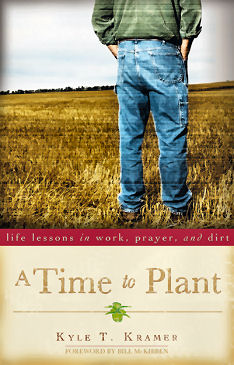
|
Posted February 24, 2011
Book: A Time to Plant: Life lessons in work, prayer and dirt Author: Kyle T. Kramer Sorin Books, Notre Dame, IN. 2011. Pp. 173 An Excerpt from the Introduction:
. . .In writing this book, I hope to reach those who, like me, havenít read quite enough self-help books (or followed through on their advice), who donít quite have it all together, whose band accounts are not flush, who aspire and hope but also stumble and sin. Because my own life includes both the pragmatic concerns of farming and family-raising among no-nonsense rural neighbors, as well as the world of Catholic ministry and spiritually. Iím interested in how simplicity and sustainability can become not just a genteel hobby, or even an earnest, well-though-out lifestyle choice. Iím interested in home economics as a spiritual discipline, as well as a realistic, practical, truly democratic trend. An Excerpt from the Book: I donít think it was an accident that my interest in farming and food tended to parallel my attraction toward the Anglican and Catholic strains of Christianity. In these traditions, the central symbolic act of worship is the Eucharist, which draws, transforms, and binds together believers of every stripe in a common act of breaking bread and sharing wine. Eating is an inescapable and fundamental way in which we relate to the world, which Jesus, in centering so much of his ministry around meals, must surely have recognized. Like a sacrament, food is an outward and visible sign of a deeper, complex, and generally hidden reality. It can be a symbol of destruction, as when poorly grown food represents the layers of personal, cultural, economic, political, and environmental ill health that are its causes or effects. It can be a symbol of health and healing, as when a simple, delicious, and nutritious meal embodies the love and care involved in its growing, sharing, and eating. Like the Eucharist, good food represents the partnership between human and divine effort: fruit of the Earth, whose seasons and cycles of growth are in Godís control; and the work of human hands, which cooperate with nature and natureís God to coax crops from the soil. Table of Contents: Part One 1. Coming home 2. Settling in 3. Loneliness and love 4. Building home Part Two 5. Farming and food 6. Children at play 7. Open house, open heart, hospitality and belonging 8. Simplicity, sacrifice, and the struggle to stay put Conclusion: Home-grown hope |
|
